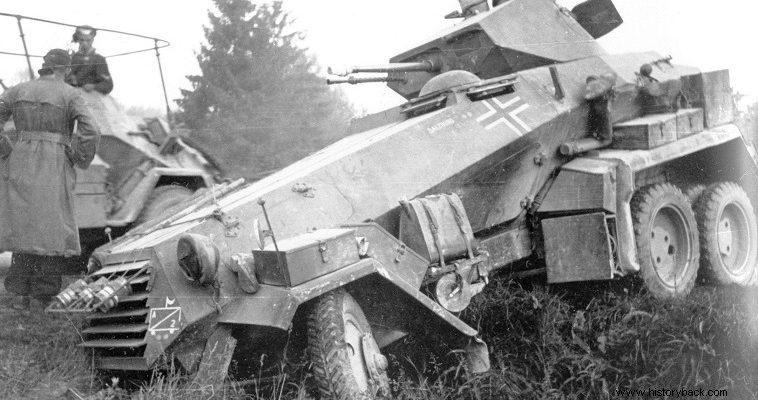
The German reconnaissance units (Aufklärungsabteilung =reconnaissance detachment) were the spearhead of the Panzer Divisions. Being a miniature, essentially, of the familiar divisions, possessing elements of all arms, but fully motorized, they were able to operate at a very great depth within the enemy formation collecting information on the enemy's layout and armament, on the routes and valuable territories characteristics and strongholds of the opposing defense.
Units specially formed to carry out reconnaissance missions have existed since the beginning of history. During World War I, reconnaissance units were reinforced, for the first time, with motorized, armored vehicles. It was the beginning of the replacement of the horse by the machine.
Agility, speed, protection, firepower
In the operations of motorized and armored formations the factors of firepower, armor, agility and maneuverability each have their own special importance. The above also applies to an identification unit. In recognition units, however, what matters is the most suitable mix of all these characteristics, for the benefit of flexibility and agility.
A reconnaissance unit exists, in essence, to collect information about the formation in question. Its value lies precisely in this parameter and secondarily in its ability to fight against the enemy. Their role was mainly to reconnoitre the enemy location in great depth in order to provide accurate and secure information to the division concerned.
Consequently, tactical flexibility and excellent communications were essential to accomplishing their mission. According to German officers who served in reconnaissance battalions their most powerful weapon was the radio. However, in many cases the reconnaissance divisions had to operate conventionally, either covering the front, or the flanks of the formation in question, or even as a strike force.
General Gunderian accurately describes the doctrine of the use of these units as well. He considers it a vital matter to carry out extensive, in-depth reconnaissance before carrying out an attack by tank forces. From the reconnaissance units, Guderian expected to carry out reconnaissance at a depth of up to 50 km The ideal was for ground reconnaissance units to be able to cooperate with Luftwaffe reconnaissance.
Organization and features
German reconnaissance units were influenced by their mounted predecessors. Instead of horses, however, there were now lightly armored vehicles. Instead of infantry light infantry "Hunters" there were now sub-units of motorcyclists-machine guns. Horse-drawn artillery was replaced by motorized artillery and reinforced with anti-tank guns, while the available Engineer element ensured that the command would not be forced to halt at the slightest obstacle.
In 1939 the organization of a reconnaissance battalion (Aufklaerungs Abteilung) of the German Air Force was as follows:
– Command platoon
– Two companies of light armored vehicles
– A company of motorcyclists – machine guns
– One heavy weapons company, reinforced with an Engineer platoon
– Repair, supply and transport echelons
The management echelon also had a Transfer team, in addition to the usual structure. Through this group, the command of the battalion was always in contact with its combat elements and immediately transmitted the information it received to the higher echelons. Light armored vehicle companies each consisted of a command group with one radio vehicle and four armored vehicles, a heavy ulama with six six- or eight-wheeled armored vehicles, and two ulama with lighter four- or six-wheeled armored vehicles.
The heavy ulama consisted of three groups of two vehicles each, while the two light ulama consisted of two groups of three vehicles each. In each group at least one vehicle had to be wireless.
The motorcycle company consisted of the command group, three rifle platoons, each with three squads, each with two MG-34 machine guns and a 50mm light mortar. The company also had a machine gun platoon, with four guns. The company was fully motorized, having motorcycles with sidecars, but also general purpose vehicles.
The heavy weapons company it had a light gun platoon, equipped with two 75mm howitzers, an anti-tank platoon with initially three, and later five, 37mm anti-tank guns and an Assault Engineer platoon with three squads, each with a machine gun and engineer equipment. He also owned utility vehicles.
Essentially, it becomes clear that each reconnaissance battalion was an autonomous fast-moving unit of all weapons, capable of moving independently, at great depth, easily overturning weak enemy resistance. Thanks to his armored vehicles and anti-tank weapons, he could face even armored opponents. Thanks to his machine gun company he could gain the superiority of fire from enemy infantry, covering the advance of friendly armored vehicles.
Thanks to his Engineer element, it was certain that no small river, minefield or other obstacle would block his way. Thanks to his technical echelons, his administration was certain that its vehicles would always be operational, would never "run out" of fuel, but would also not be deprived of supplies, food and natural ammunition. Virtually every reconnaissance battalion was a battle group (Kampfgrouppe) in its own right, long before this practice became the norm in the German Army.
